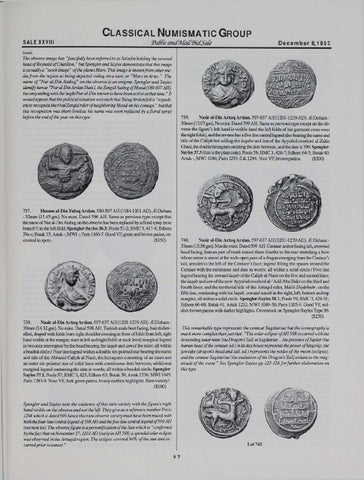C L A S S I C A L NUMISMATIC GROUP SALE XXVIII
fPußßcand(ΑίαίίVidSaL·
D e c e m b e r 8,1 9 9 3
(cont). The obverse image has "fancifully been referred to as Saladin holding the severed head of Reynold ofChatillon, " but Spengler and Sayles demonstrate that this image is actually a "slock image " ofthe planet Mars. This image is knownfrom other media from the region as being depicted riding on a ram, or "Mars in Aries." The name of "Nur al-Din Atabeg" on the obverse is an enigma. Spengler and Sayles identify himas 'Wur al-Din Arslan S hah I, theZengidAlabeg ofMosul (589-607AH), the only atabeg with the laqab Nur al-Din known to have been active at that time ."It would appear that the political situation was such thatYuluq Arslanfelt it "expediera to recognize the rival Zengid ruler ofneighboring Mosul on his coinage, " but that this recognition was short-lived as his name was soon replaced by a floral spray before the end of the year on this type. 739.
Nasir al-Din Artuq Arslan. 597-637 AH (1201-1239 AD). M Dirham 30nm (13.07 gm). No mint Dated 599 AH. Same as previous type except on the obverse the figure's left hand is visible (and the left folds of his garment cross-over the right folds), and thereversehas afiveline central legend also bearing the name and tide of the Caliph but adding the laqabs and ism of the Ayyubid overlord al-Zahir Ghazi, the double hexagram omitting the dots between, and the date is 599. SpenglerSayles 373 (this is the plate coin); Poole 58; BMC 3,426-7; Edhem 64-5; Butak 40; Artuk -; MWI 1046; Paris 1291-2 & 1294. Nice VF, brown patina. ($200)
737. Husam al-Din Yuluq Arslan. 580-597 AH (1184-1201 AD). ^Dirham - 32mm (15.45 gm). No mint. Dated 596 AH. Same as previous type except that the name of Nur al-Din Atabeg on the obverse has beenreplacedby a floral spray (rose branch?) in the left field Spengler-Sayles 363; Poole 51-2; BMC 3,417-8; Edhem 59a-c; Butak 35; Artuk -; MWI -; Paris 1166-7. Good VF, green and brown patina, encrusted in spots. ($150)
740. Nasir al-Din Artuq Arslan. 597-637 AH (1201-1239 AD). Λ· Dirham 33mm (15.56 gm). Mardin mint. Dated 599 AH. Centaur-archer facing left, crowned head facing, human part of trunk turned three-fourths to the rear stretching a bow whose arrow is aimed at the wide-open jaws of a dragon emerging from the Centaur's tail, annulet to the left of the Centaur's face; legend filling the spaces around the Centaur with the mintname and date in words; all within a solid circle / Five line legend bearing the ism and laqab of the Caliph al-Nasir on thefirstand second lines; the laqab and ism of the new Ayyubid ovedord al-'Adil Abu Bakr on the third and fourth lines; and the territorial tide of the Artuqid ruler, Malik Diyârbakr, on the filth line, continuing with his laqab, ism and nasab in theright,left, bottom and top margins; all within a solid circle. Spengler-Sayles 38.1; Poole 59; BMC 3,429-31; Edhem 66-68; Butak 41; Artuk 1232; MWI 1049-50; Paris 1205-9. Good VF, reddish-brown patina with darker highlights. Overstruck on Spengler-Sayles Type 36. ($250)
738. Nasir al-Din Artuq Arslan. 597-637 AH (1201-1239 AD). JE Dirham 30mm (14.32 gm). No mint Dated 598 AH. Turkish male bust facing, hair dishevelled, draped with folds from right shoulder crossing in front of folds from left, right hand visible at the margin; stars in left andrightfieldsat neck level; marginal legend in two arcs interrupted by the head bearing the laqab and ism of the ruler, all within a beaded circle / Four line legend within a double six-pointed star bearing the name and tide of the Abbasid Caliph al-Nasir, the hexagram consisting of an inner and an outer six-pointed star of solid lines with continuous dots between; additional marginal legend containing the date in words; all within a beaded circle. SpenglerSayles 37.1; Poole 57; BMC 3,425; Edhem 63; Butak 39; Artuk 1236; MWI 1045; Paris 1283-9. Near VF, dark green patina, heavy earthen highlights. Rare variety! ($100)
Spengler and Sayles note the existence of this rare variety with thefigure'sright hand visible on the obverse and not the left. They give as a reference number Paris 1294 which is dated599 hence this rare obverse variety must have been muled with both thefour-line central legend of598 AH and thefive-linecentral legend of599 AH (see next lot). The obversefigureis a personification of the Sun which is "confirmed by the fact that on November27,1201 AD (early in AH 598) a spendid solar eclipse was observed in the Artuqid region. The eclipse covered 84% of the sun and occurred prior to sunset. " 9 7
This remarkable type represents the centaur Sagittarius but the iconography is much more complex than just that. "The solar eclipse of AH 598 occurred with the descending lunar node (the Dragon s Tail) inSagittarius.... the presence of Jupiter (the human head of the centaur, ed.) in its day house represents the power of kingship; the jawzahr (dragon's head and tail, ed.) represents the nodes of the moon (eclipse); and the centaur Sagittarius ( the exaltation of the Dragon's Tail) enhances the magnitude of the event." See Spengler-Sayles pp.123-126for further elaboration on this type.
Lot 741
